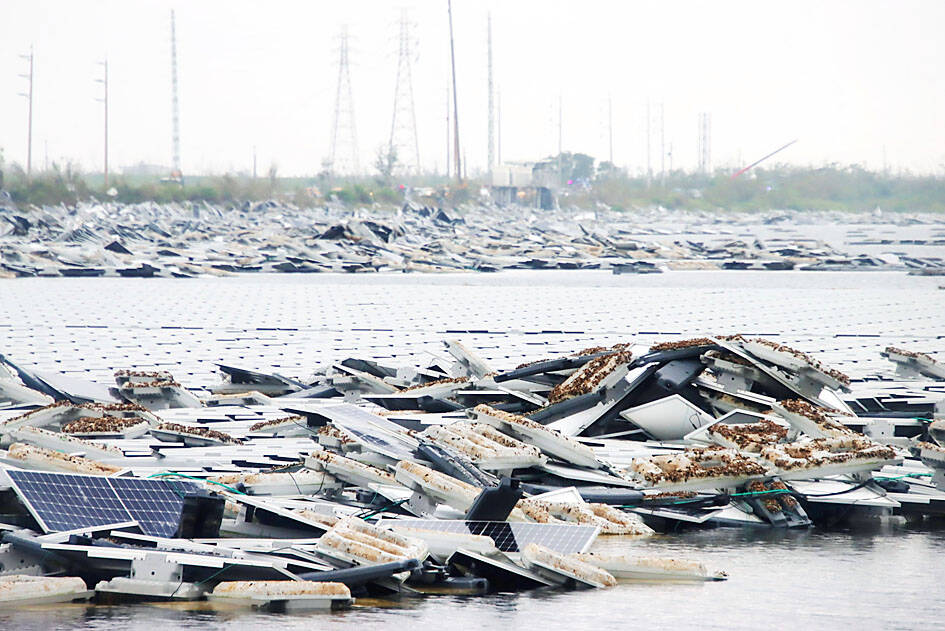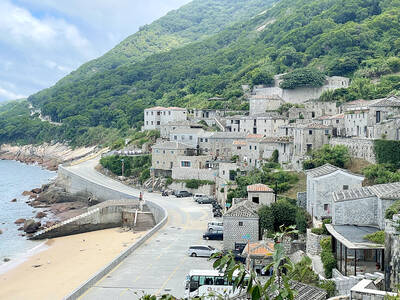It is to expected take 155 days to completely remove the 135,000 damaged solar panels left by Typhoon Danas in July, environmental groups said on Wednesday, urging the establishment of a mechanism to manage waste solar panels and ensure reasonable recycling fees.
High-value utilization of waste solar panels is currently prioritized at a nationwide processing capacity of 6.5 million tonnes per month, meaning that the remaining 135,000 damaged panels would require 155 days to be cleared out, Miaoli County Environmental Protection Association president Chen Chi-chung (陳祺忠) said.
Panels that are too deformed to be high-value utilized must be crushed or thermally melted, but such processes would generate lots of waste materials that require further control, he said, adding that relevant data should be disclosed.

Photo: Lin Yi-chang, Taipei Times
Chen also suggested the recycling fees levied on solar panel users should be calibrated to actual processing fees.
As waste panels’ high-value utilization fees range from NT$25 to NT$30 per kilogram, processing 1 kilowatt of waste panels would cost NT$1,953 to NT$2,343, he said.
However, the solar panel recycling fund set up in 2020 levies only NT$1,000 per kilowatt in recycling fees on users, which is payable over a 10-year period and clearly insufficient, Chen said.
Herlin Hsieh (謝和霖), secretary-general of Taiwan Watch Institute, said that concern had been raised over the recycling fee being insufficient when the fund was established, but it was countered by the viewpoint that the fund’s interest accumulated over 20 years would be enough to cover recycling fees in the future.
While the reality five years later is not as optimistic as initially thought, advanced recycling techniques and increased labor costs have driven up waste panel recycling costs, he said, calling on the Energy Administration to increase the rate of recycling.
Changhua Environmental Protection Union researcher Lin Cheng-han (林政翰) said that transportation and manual dismantling would incur fees on top of the recycling fee.
Panels that cannot be high-value utilized would also push up the costs, as their reuse value is relatively low, he said.
If waste management costs become so high that panel users are unwilling to bear them, illegal disposal could ensue, Lin said, urging the government to make the inquiry system of solar panel serial numbers open to the public to allow for greater oversight.
In response, the Resource Circulation Administration said the Ministry of Environment would conduct a comprehensive examination of the waste panel management process along with the Ministry of Economic Affairs to propose a standard operation procedure.
The environment ministry is also planning to amend the Waste Disposal Act (廢棄物清理法) to enhance the product liability systems for solar panels and wind turbine blades, it said, adding that the bill is expected to be sent to the legislature for review by the end of this year.
The Energy Administration said the economic ministry would discuss the feasibility of increasing waste panel recycling fees.
Additional reporting by CNA

The Chinese military has built landing bridge ships designed to expand its amphibious options for a potential assault on Taiwan, but their combat effectiveness is limited due to their high vulnerability, a defense expert said in an analysis published on Monday. Shen Ming-shih (沈明室), a research fellow at the Institute for National Defense and Security Research, said that the deployment of such vessels as part of the Chinese People’s Liberation Army (PLA) Navy’s East Sea Fleet signals a strong focus on Taiwan. However, the ships are highly vulnerable to precision strikes, which means they could be destroyed before they achieve their intended

The first two F-16V Bock 70 jets purchased from the US are expected to arrive in Taiwan around Double Ten National Day, which is on Oct. 10, a military source said yesterday. Of the 66 F-16V Block 70 jets purchased from the US, the first completed production in March, the source said, adding that since then three jets have been produced per month. Although there were reports of engine defects, the issue has been resolved, they said. After the jets arrive in Taiwan, they must first pass testing by the air force before they would officially become Taiwan’s property, they said. The air force

GLOBAL: Although Matsu has limited capacity for large numbers of domestic tourists, it would be a great high-end destination for international travelers, an official said Lienchiang County’s (Matsu) unique landscape and Cold War history give it great potential to be marketed as a destination for international travelers, Tourism Administration Director General Chen Yu-hsiu (陳玉秀) said at the weekend. Tourism officials traveled to the outlying island for the Matsu Biennial, an art festival that started on Friday to celebrate Matsu’s culture, history and landscape. Travelers to Matsu, which lies about 190km northwest of Taipei, must fly or take the state-run New Taima passenger ship. However, flights are often canceled during fog season from April to June. Chen spoke about her vision to promote Matsu as a tourist attraction in

PAWSITIVE IMPACT: A shop owner said that while he adopted cats to take care of rodents, they have also attracted younger visitors who also buy his dried goods In Taipei’s Dadaocheng (大稻埕), cats lounging in shops along Dihua Street do more than nap amid the scent of dried seafood. Many have become beloved fixtures who double as photography models, attracting visitors and helping boost sales in one of the capital’s most historic quarters. A recent photo contest featuring more than a dozen shop cats drew more than 2,200 submissions, turning everyday cat-spotting into a friendly competition that attracted amateur and professional photographers. “It’s rare to see cats standing, so when it suddenly did, it felt like a lucky cat,” said Sabrina Hsu (徐淳蔚), who won the NT$10,000 top prize in